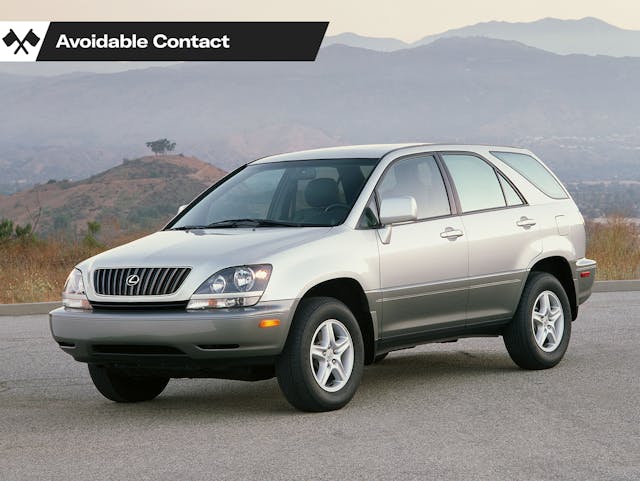Media | Articles
Avoidable Contact #116: Living in the world the Harrier made

Spoiler alert: In the next year you’re going to see an increase in the number of new-car reviews here at Hagerty. As the so-called “legacy” magazines continue to fade out, thin out, and struggle through unconvincing transitions to “lifestyle” rags, there will be fewer and fewer people and outlets willing to undertake honest, fair, and context-sensitive reviews of new vehicles. We don’t rely on the manufacturers for advertising money or long-term loaner cars, so I’d like to think we will have some latitude to tell you the straight story about what we drive. If you agree with us, feel free to insure a vehicle with us or join the Hagerty Drivers Club.
End of commercial message / ominous warning.
Part of doing new-car reviews is that we will have a tiny fleet of new cars sitting around the office. It’s traditional in this business that the boss always takes the nicest cars for himself. Which is how I ended up forcing our young superstar editor, Grace Houghton, to spend the weekend driving a stick-shift BMW M4 while I snagged the keys for something much nicer … a Lexus RX450h F-Sport.
Don’t laugh.
I spent about a decade and a half writing with considerable vitriol about the Lexus RX; at one point dismissing it as a “suppository-shaped Toyopet for exceptionally stupid customers” or something like that. This did not worry Lexus in the slightest, because they could sell every one they made at a handsome markup regardless of what I thought or said. They also knew that I’d eventually wind up coming around to their side of the debate. They had my number, so to speak. The new RX450h is tailor-made for a near-as-dammit-to-50-year-old man with aching bones and a fondness for covering ground in a hurry. From the ’80s hi-fi aesthetic of the HVAC panel to the self-assured way it handles triple-digit speeds in heavy rain, the current top-dog RX has been ruthlessly optimized for its customer base—even the people in the customer base who didn’t know they were in the customer base until they got settled behind the wheel of one.
Marketplace
Buy and sell classics with confidence
If the current Lexus podwagon has charmed me, why did the original offend me? Well, not to put too fine a point on it, but the Lexus RX (aka Toyota Harrier in some markets) is the reason our automotive world looks the way it does today. It was a superbly-conceived vehicle that launched a million cut-rate imitators, from the Ford Edge to the Porsche Cayenne. It’s responsible for the way your Miata feels surrounded by a wall of steel in traffic, it’s the reason new cars get worse fuel economy than their ’80s predecessors, and it’s the template from which 75 percent of new cars are taken.
Hard to believe it showed up just 23 years ago, in 1998.
The writing was kind of on the wall ahead of time, because the RAV4 had arrived just a few years before to tremendous acclaim. Toyota had proven that its unibody car platforms were strong enough to support a heavier body and higher hip point. It seemed obvious that there would eventually be a raised-roof Camry. What was not obvious: that the Harrier would come to the country as a Lexus, rather than as a Toyota. At the time, Lexus was primarily known for an S-Class clone with a V-8 and a leather-interior Camry styled to mildly resemble its bigger brothers. There was no “Lexus design language.” The first RX300 didn’t look like anything in particular. Certainly didn’t look like a Lexus; it looked like a scared cat, from the hunched back to the on-stilts suspension setup. The interior was fairly wacky in the best JDM tradition: lower-cost plastics, odd colors, a vertically-mounted shift lever to the left of an oversized center stack.
Someone once wrote that the only thing keeping the fourth-generation Camaro from being counted among the world’s great automotive designs was the the fact that you could find a half-dozen in every buy-here-pay-here lot. Similarly, if Lexus had never brought the RX to America, the occasional sight of a JDM import Harrier would have driven import spotters crazy, the same way people go nuts for a Mazda Bongo or something like that. Go back and look at the 1998 car with fresh eyes. It looks weird.
In the early years, you could get cloth seats in the RX. There were stick-shift variants available in Canada—and possibly in the USA; it’s hard to know if any were actually delivered. Although the introductory marketing materials showed the RX doing some “Jeepy” things, a nontrivial number of RXes were sold with front-wheel drive. Lexus didn’t seem to know how to market it, how to configure it … or what to do with the demand for it, which was substantial from Day One.
And why not? It might have looked like a Starship Troopers bug, but the RX300 took the existing Lexus virtues—combination of semi-luxury branding with quarter-million-mile reliability—and added “command seating position” to the mix. Lexus was already a brand for timid buyers, since it promised you 90 percent of an S-Class with 10 percent of the repair bills. Now they had a product for people who felt safer when they were sitting higher. And they were off to the races.
The RX sells about 100,000 units a year, without fail, at transaction prices between $45K and $60K. It is a serious economic force with which to reckon. It keeps the lights on at Lexus dealers. It pays for adventurous but unpopular products: LFA, CT200h, the various coupes. It is the default-choice purchase for a lot of people who could afford something much more expensive, should they choose, yet it’s also an aspirational vehicle for which younger families will struggle.
The runaway success of the RX, despite its humble underpinnings and aesthetic flaws, should have emboldened the competition to make a better alternative, but by and large they simply tried to be different. Infiniti tried a rear-wheel-drive “bionic panther” alternative in the first FX. Mercedes and BMW went rear-drive and Nurburgring-capable. Cadillac built a lifted RWD sports sedan, the SRX, that was the least crossover-ish crossover in history. Other players went directly to “three-row” offerings like the Buick Enclave.
Ford’s decision to introduce the Edge a decade after the first RX was, therefore, revolutionary for being not revolutionary at all. It followed the RX formula to the letter: hunchback shape, sedan underpinnings, hefty price. And it was a massive success. You could say it was the first-gen Taurus, and the RX was the “aero” Audi 5000, of crossovers. In both cases Ford just brought the appeal of a boutique product to Main Street. And once Ford did it, everyone followed suit, shamelessly.
Take away the pickup trucks and a few compact sedans, and then the rest of the country’s best-seller chart is basically a tribute to the original RX300. Front-wheel-drive five-seat lifted sedans, awkward and unlovely, not too fast and not at all interesting, selling for considerably more than the cars on which they were based. The newest Hyundai Tucson, in particular, feels like a first-generation Harrier reimagined for the current day, right down to the bizarre multi-level nose. Even the so-called enthusiast market is a pawn in the RX game. What is a Porsche Macan, if not an RX300 for people who don’t worry about service visits? What is an Audi SQ5?
I could go on for hours about This Is A Bad Thing And Here’s Why That’s A Problem. Nobody cares. The extra weight, the extra fuel consumption, the mindless addiction to high-rise seating? It’s like oxygen now. You don’t even realize it’s there. It seems hard to believe that we could have ended up with a 2021 where the 3-Series Bimmer was still the big dog of entry-level prestige, or where Ford Explorers were still based on Ford Rangers. Could have happened. Easily. The RX300 is why those alt-futures didn’t happen. This is the RX300’s world. We just live here now.









